Atlas of Egyptian Art
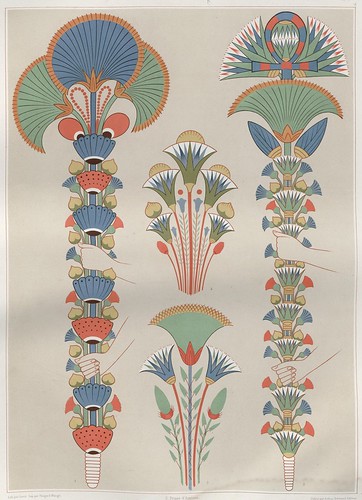
Stylised bouquets painted in tombs during the 19th and 20th Dynasties.
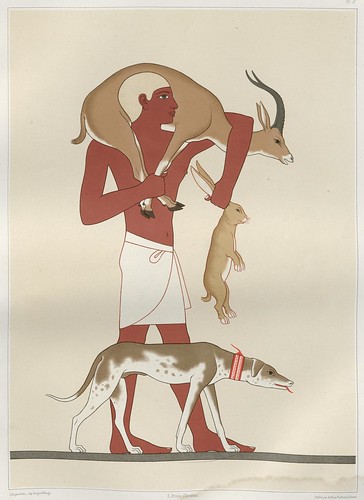
Return from the Hunt - from a painting at the Theban Necropolis (17th Dynasty)
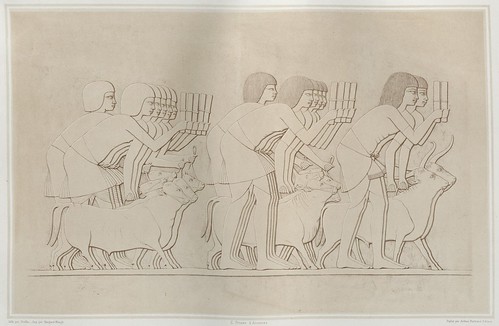
Counting the oxen - drawing of a bas-relief found in the tomb of Chamhati,
the superintendent of the royal domains during the 18th dynasty
the superintendent of the royal domains during the 18th dynasty
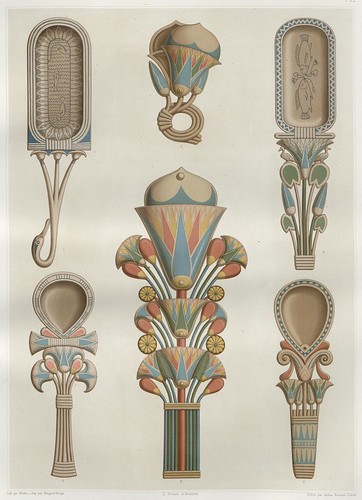
?Perfume containers and grooming utensils
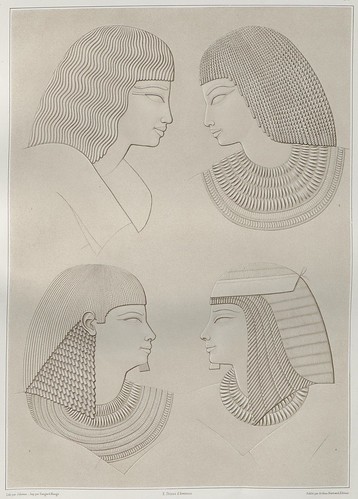
Profile portraits drawn from bas-relief figures at the Necropolis of Thebes.

Necklaces, bangles, rings and jewellery segments from various periods

A hunter returns to his barge - from a 12th Dynasty tomb painting
(2100-1900BC) at the cemetery of Beni Hasan*
(2100-1900BC) at the cemetery of Beni Hasan*
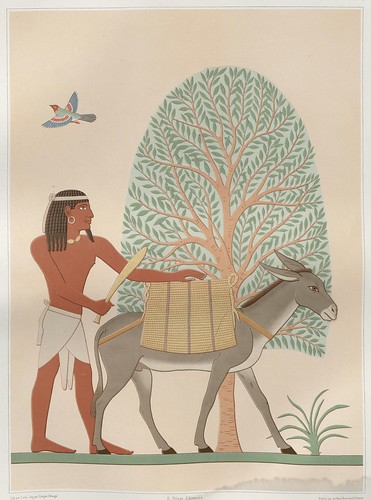
A native from the fabled and mysterious Land Of Punt carries goods on an ass
- from a painting found in the ?valley of El-Assacif at Thebes
- from a painting found in the ?valley of El-Assacif at Thebes
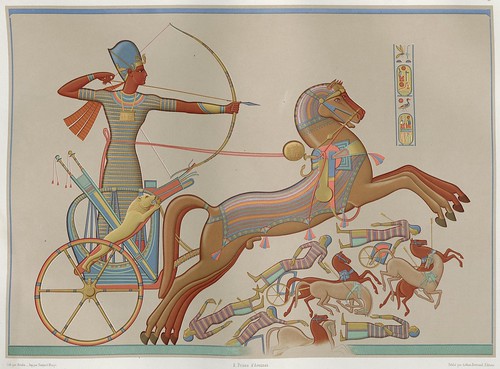
By the banks of the Orontes river, King Ramses II (Ramses-Meiamoun or Ozymandius* or Ramesses the Great, the third ruler of the XIXth dynasty and considered the most powerful Pharaoh of all) battles the Hittites (Khetas) from his chariot. Although not stated, this illustration presumably derives from a sculpture or bas-relief at the Ramesses II temple at Abu Simbel in Nubia.
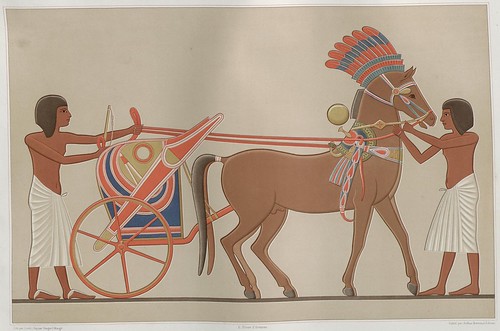
The Prince's chariot - from a sculpture at el-Amarna [Akhetaten] (300km south of Cairo)*; "..established and built by the Pharaoh Akhenaten of the late Eighteenth Dynasty (c. 1353 BC), and abandoned shortly afterwards.."
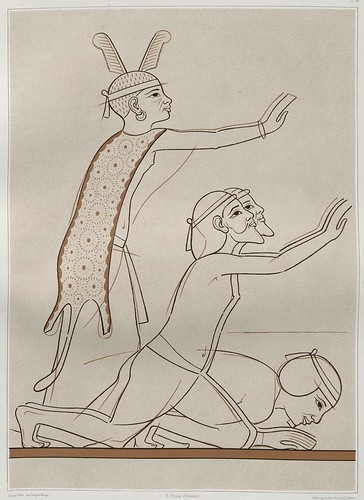
Sketch (of a sketch) of ?purification ritual foreigners prostrating before the Pharaoh from the Necropolis at Thebes
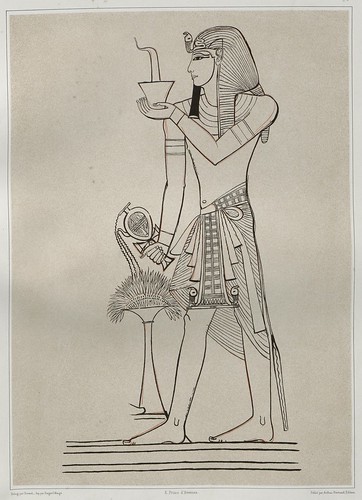
Sketch of Seti I, father of Ramses II from the Necropolis at Thebes

Satirical anthropomorphic 'cartoons' from an ancient Egyptian papyrus manuscript
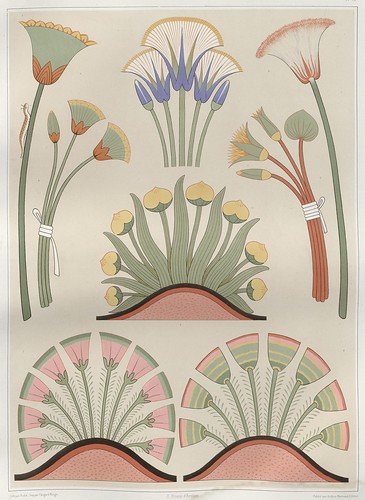
Flowers and plants derived from various monuments
[I've posted parts of a similar image before]
[I've posted parts of a similar image before]
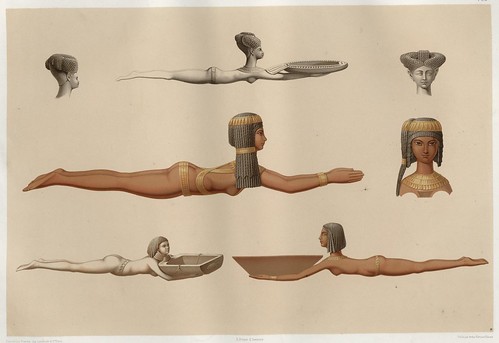
Painted wooden spoons and perfume vessels featuring
female figures of contrasting ethnicities or rank (or both)
female figures of contrasting ethnicities or rank (or both)
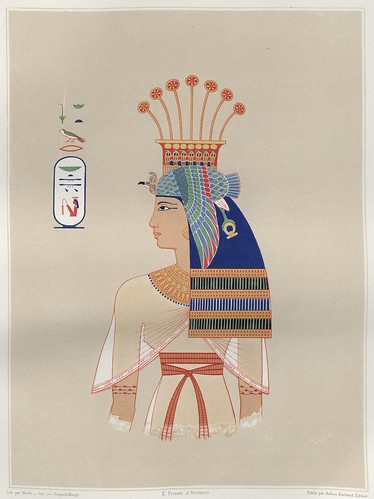
Portrait of Queen Nebto, daughter of Ramesses II (19th dynasty)

Weighing and judgement of the soul during
a funerary ritual at the court of Osiris (18th dynasty)
a funerary ritual at the court of Osiris (18th dynasty)
[click through for full-sized versions;
all these chromolithographs were cropped from full-page illustrations]
all these chromolithographs were cropped from full-page illustrations]
Émile Prisse d'Avesnes (d'Avennes) (1807-1879) was an important mid-19th century French Egyptologist and something of a polymath. He was a soldier, engineer, writer, illustrator and talented linguist.
From 1827 to 1844 d'Avesnes resided in Egypt, teaching cartography and working as an engineer for a time, but eventually he devoted himself to documenting and studying the archaeological treasures from ancient Egypt. He became proficient in hieroglyphs, on the back of Champollion's translations of the Rosetta Stone, and learned to speak at least half a dozen languages fluently during his expeditions around Egypt and further afield in the Arab world.
Ransacking of the artefacts was rife in those days of course and d'Avesnes helped excavate and transfer a large shipment of portrait reliefs from the Valley of the Kings to France, ostensibly to prevent their theft and use as local building material. The brazen act would earn d'Avesnes the Legion of Honour award when he returned to his homeland.
He published a number of Egypt-centric works in the decade following his return to France and eventually set about obtaining support for a further expedition which was undertaken from 1858 to 1860. On this occasion he was accompanied by a photographer (the photographs are now located in the French National Library).
"When he returned to Paris in I860; Prisse brought 300 folio drawings of paintings of various epochs, each up to seven or eight meters (23 to-26 feet) long; 400 meters (1300 feet) of paper impressions of bas-reliefs; 150 photographs of architectural and ornamental details, plans,sections and elevations; and 150 stereoscopic photographs, together with his enormous collection of drawing and notes. He also brought back, and later donated to the Louvre, the skulls of 29 mummies which he had identified by era, position and individual name." [source]
The most important of d'Avesnes' publications -- the subject of this post -- was released in installments over ten years and eventually compiled into a three volume work (one text and two illustrated atlases) in 1878 entitled: 'Histoire de l'Art Égyptien: d'après les Monuments; Depuis les Temps les Plus Reculés Jusqu'à la Domination Romaine' (~The history of Egyptian art from monuments from the earliest times up to Roman occupation).
- The images above come from the third volume of 'Histoire de l'Art Égyptien' which is (the only volume) available from Universitätsbibliothek Heidelberg (click 'atlas 2', anything below 'inhalt' and then 'vorschau' for thumbnails).
- Alternatively, all of the illustrations from the two atlas volumes can be seen at NYPL (albeit in smaller format).
- Prisse: A Portrait at Saudi Aramaco World.
- Previously in particular (all very much related and worth seeing): L'Art Arabe features similarly wonderful chromolithographs by Émile Prisse d'Avesnes and associated information. || Egyptian Monuments and Hieroglyphs [Karl Lepsius - who is named on at least one of the plates by d'Avesnes as the originator of the illustration] || The Monuments of Egypt and Nubia [featuring the results of work done by Jean-François Champollion and Ippolito Rosselini]
- Previously in general -- from the lackadaisical categorising system at Delicious bookmarks -- Egypt & Arabic.
- A new edition of d'Avesnes' opus was released in 2000 as: 'Atlas of Egyptian Art' {"E. Prisse D'Avennes" as author}.
- Et en Français: Émile Prisse d'Avennes (Egypt.edu) & Émile Prisse d'Avesnes (1807-1879), Willem de Famars Testas (1834-1896) et A. Jarrot à BNF.



















33 comments :
This is beautiful stuff. I might have to get the book. :-)
lovely!
Very cool- the original cartoonists!
I woke up half an hour ago to wish my parents and brother Happy New year (they perpetually live 8 hours in the past), and thanks to Blogger's "Blog of Note" feature, what should be my first surprise of 2010? Why, BibliOdyssey, of course. : )
As an ardent admirer of all things ancient Egypt, your post has officially made my day and hopefully set the tone for the year ahead. lol
Happy 2010!
Congrats U have a Great Blog and Got new year Gift from Blogger as Blog of the Note. WOW. how exciting this gift is for U. Congrats Again
Congratulations on your Blog of Note. I love your Egyptian Arts.
From a Scots Lass living in South Africa.
Something worth seeing and learning. Interesting!
Beautiful art, thanks for sharing :-)
It is very interesting and thought provoking
Fascinating insight into Egyptian culture and history.
Wonderful images.
OMG! I'm so in love with this picture, I hope you don't mind I use them for my layouts...
Thank you so much for sharing them, I appreciate the hard work and will give you the credit for its.
Thank you so much..
Hugs,
Hmm, like something from National Geographic! I'm glad I found this site, I love reading this kind of stuff.
The lives of the Pharaohs and how the people respect them are so damn intriguing, I don't mind having to read a couple hundred pages about the rulers of Egypt!
Much Love,
Egyptian art is simply the best.
i got the chance to visit a different type of blog through "Blog of Note"
will like to visit again and again.
anyway, congrats! being a "blog of note"
Factual--great! :)
These illustrations are simply stunning... I'm getting goosebumps just looking at them!...imagine "300 folio drawings...400 metres of paper impressions of bas-reliefs.. 150 photographs" what an incredible life it must have been to spend so much time doing what sparks you up inside... true bliss :)
Thank you for sharing this... have a wonderful 2010
love it!
Thanks everybody and happy new year!
Now, is it just me or does it seem a little bit ironic that the blog of a search engine company would fail to notice that in their archives from a few years ago is an entry for BibliOdyssey as a blog of note? Perhaps they reached the end of the Internet and are now making their way back to the beginning?
Regardless, I am flattered by the recognition: it's always nice to receive encouragement and that remains just as applicable today as it was the first time around, although I was probably closer to a heart attack from shock back then.
So, 2010 huh? (that's twenty-ten, not two thousand and ten) I'm hoping it's the year of civil behaviour on the internet. Surely the age-old forces for good have the best opportunity to prevail in this great melting pot? Here's hoping. Be nicer.
Oh, sorry - for anyone wondering what is being mentioned here, Google's Blogs of Note blog includes BibliOdyssey as it's 31st December 2009 choice. I'm hoping it's a good omen for the year ahead.
That is a really cool entry. I'm new to blogspot... but I must say... some pretty awesome stuff there!
This is great! Everything Egypt-related is always fascinating and a real treat.
I'll bet it was Blogger's last Blog of Note (2006 or so) that lured me into this orbit. I kinda think so although I could also be senile or hung over.
I'm all for the satirical animal item. I don't think I'd ever seen an Egyptian example before.
Happy New Year again-ish!
This blog is interesting, I always love to see ancient egypt stuffs. I'm adding this blog to my blog roll lists.
Egyptian pictures are interesting.
so nice.
Arrrgh. And you wonder why so few people are ascending after death today. God bless.
wow !! this is so interesting
thanks for sharing
Thank you for that post!, Is beautiful!
Very beautiful.
The "?purification ceremony" is actually just a few excerpted examples of foreigners making prostrations to Pharaoh. There's what looks like a Nubian on the left showing the initial position of the prostration process, two Syrians/Canaanites in the middle (though they're dressed as Egyptians, oddly) showing the middle of the process, and an Egyptian shown on his face in the final part of the prostration process. This is the "bending the knee": one ends up on one's belly, face down on the ground, hands extended forward, the right leg extended, but the left leg bent, so that one can quickly stand up again on the left foot.
Thanks a lot Kevin, I adjusted the caption.
(I think I put the question mark in to denote my disbelief of the translation as I recall)
Just wanted to let you know that there's an award for you on my site. : )
Very beautiful.
Post a Comment
Comments are all moderated so don't waste your time spamming: they will never show up.
If you include ANY links that aren't pertinent to the blog post or discussion they will be deleted and a rash will break out in your underwear.
Also: please play the ball and not the person.
Note: only a member of this blog may post a comment.